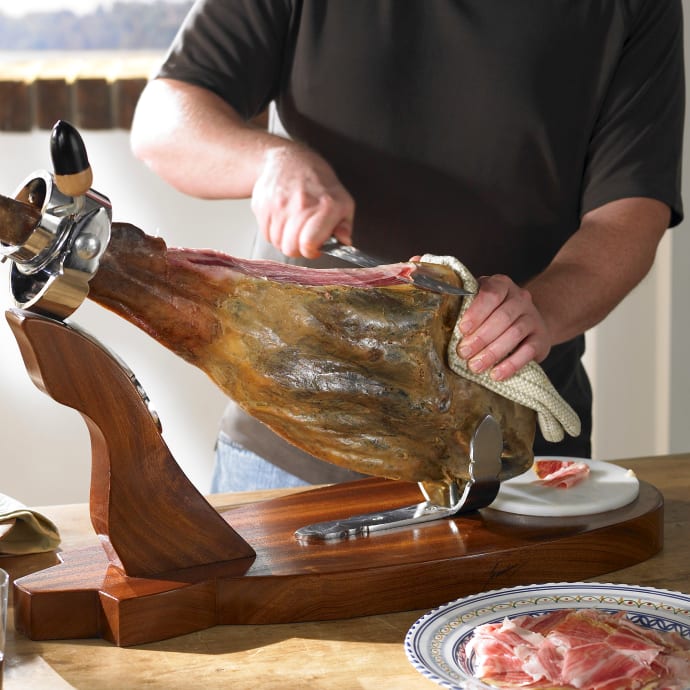
Tastes: The Spanish Cure
Wine Spectator
-
July 1, 2003
Iberian hams and sausages are finally becoming available in the United States.
Sam Guigino
Chances are you've never tasted the ham that many consider the best in the world. Called Ibérico, after its region of origin in Spain, it has a firmer texture and a more intense, gamier, flavor than other well-known cured hams. It's also illegal in the United Stated -- until 2005. While Italians take ham, most notably their Prosciutto di Parma, very seriously, the Spanish raise ham-devotion to a whole new level, consuming double what the Italians eat. "For the Spanish, ham is everything," says Don Harris, owner of Tienda.com, a purveyor of Spanish products in Williamsburg, VA. "I once saw a truck driver buy a whole ham at a truck stop to snack on along the way."
Ibérico hams will be available in the United States in 2005 -- the first year that these hams will be produced to meet the U.S. Department of Agriculture's stringent standards. But right now, you can at least get the idea by tasting another Spanish ham, called serrano. These are not aged as long and come from pigs that are fed a different diet, but their style resembles Ibérico's and they taste great. Prior to 1997, serrano hams were banned because of concerns about a swine virus that affected much of Europe (Prosciutto di Parma was also banned). Another relatively recent stateside import is Spanish chorizo, the smoked cured pork sausage.
The Spanish have been curing hams for centuries. Originally produced mostly in mountainous areas, the ham was called jamón serrano. Jamón is the Spanish word for ham and serrano comes from the word sierra, Spanish for mountain. Virtually every region of Spain has its own version of serrano ham, though the procedure for making them is quite similar.
It begins with white pigs, normally Duroc, Pietrain, Landrace or Large White varieties, that are fed a diet of grains. Once slaughtered, the rear legs are rubbed with coarse sea salt. When the salt is washed off, the hams are hung to dry, losing up to a third of their weight. Traditionally, this step involved exposing hams to the dry mountain air. Today, most hams are cured in temperature- and humidity-controlled facilities called secaderos.
European Union regulations require serrano hams to be aged at least seven months. To obtain the seal of the Consorsio del Jamón Serrano Español, a Spanish trade group formed in 1990, hams must be aged at least nine months. "Longer aging gives the hams a more concentrated flavor and makes the meat firmer. which enables you to get [more desirable] thinner slices," Harris says.
Because Spain does not have a slaughterhouse that meets USDA standards, serrano hams imported into the United States come from pigs raised and slaughtered in Denmark or Holland. The meat is then sent to Spain for curing. "Part of the problem with the USDA is that it requires a slaughterhouse to be used only for the hams. It couldn't be used for other meats," Harris says.
Ibérico hams come from a special breed of black-footed (pata negra) pigs in southern and southwestern Spain. Until the slaughtering facilities meet USDA standards, the only way you'll be able to taste Ibérico ham is to travel to Spain. For some folks, it might be worth the trip. "It's so special that you're more likely to eat it by itself," says Penelope Casas, author of Tapas: The Little Dishes of Spain (Knopf). "The pigs exist on a diet of acorns, which gives the meat a very nutty flavor. It has streaks of fat through it, like a well-marbled steak. That adds to the flavor." So too does the length of curing, from 14 to 36 months.
All this and limited production means that a whole Ibérico ham may cost up to $800 in the United States, about four times the price of serrano ham. This has not deterred fans, though. At Tienda.com, Harris has standing order for more than 300 Ibérico hams for Christmas of 2005.
I tasted three serrano hams from two producers. Meat from an 18-month-old Redondo Inglesias bone-in ham was easily the best. The thin streaks of fat throughout each slice gave the meat a seductive creaminess. And even though my less-than-wafer-thin slices were a bit chewy, the flavor was still nutty,, rich, and elegant. Redondo's La Primera sliced ham, aged 12 months, came in beautiful, thin sheets. It had good flavor but was less refined, lacking the silky mouthfeel of the whole ham. Slices I cut from a chunk of boneless 12-month-old ham made by Navidul were similar to La Primera, but slightly coarser in texture.
Spanish chorizos had the same difficulty as serrano hams in making it into the United States. Palacios, the only Spanish chorizo in the United States, wasn't widely available until the fall of 2001. Like serrano hams, the three imported Palacios sausages come from Denmark pigs. Unlike the more common Mexican chorizo, which is usually raw, these Spanish chorizos are cured, much like Italian salami. Another distinction from the Mexican chorizo is the Spanish use of pimentón, a smoked paprika. Palacios chorizos are also made without nitrates or nitrites, unlike many cured sausages.
Several companies make Spanish-style chorizos in the United States. The best I know of is La Española Meats Inc. in Southern California. In 1982, Juana Gimeno Faraone, a native of Valencia, and her husband, Frank, started the company, which produces sausages under the Doña Juana label. Except for the U.S.-bred pigs, everything else for her sausages comes from Spain, including a reassembled curing room and an inspector from Barcelona. Faraone's sausages have names such as Pamplona and Léon that reflect the regional variations in flavor and texture.
The main difference between the Spanish and domestic chorizos I tasted was the intensity of the pimentón. In the Palacios sausages, the pimentón was more pronounced, giving them a brooding, earthy quality that the domestic sausages didn't have. The picante Palacios had a long, slow-building heat as well. The mild and picante Palacios chorizos had a firm texture while the similar tasting Palacios Oreado (which is sometimes grilled even though fully cured) was softer. La Española's Léon chorizo had and intoxicating smoked meat and leather aroma, like that of a good Rhone red. The meaty flavor had gentle hints of spices woven throughout, though the texture was a bit chewy. There was more pimentón in the Pamplona, but it wasn't as deeply embedded as it was in the Palacios. Sobrasada, a specialty of Mallorca, was soft with a rich pimentón flavor.
Generally, the best way to serve serrano ham and chorizos is by themselves, the way you get them in Spanish tapas bars. At home, the Spanish will often buy a whole ham on the bone and keep it on the counter (nestled in a holder called a jamonera), swiping off slices as they pass by during the day. You may not feel comfortable doing that. However, refrigerated hams and sausages should be brought out an hour before serving. For hors d-oeuvres, you can accompany thin slices of ham and chunks of chorizo with almonds (toasted or fried in olive oil) and olives. I like to put ham and chorizos along with potatoes in tortilla, an open-faced Spanish omelet. Try the ham (especially end pieces that don't make pretty slices) in bean stews, rice dishes and with vegetables such as braised cabbage. Sobrasada chorizo is often spread on toast and drizzled with honey for breakfast.
Quality serrano ham is also finding its way onto menus. At Ola, Douglas Rodriguez's new restaurant in Manhattan, the ham adds a salty tang to foie gras and fig empanada. In another dish, Rodriguez wraps scallops in the ham before pan-frying the morsels and serving them on a sweet corn tamale. Rodriguez also uses chorizo but prefers not to embellish it, so he puts it on a charcuterie platter.
Hands down the best wine with the hams and chorizos was a fino Sherry. Its crisp, clean fruitiness was an excellent foil to the fat and salt mix of the ham and the pimentón of the chorizos. The bubbles of a Spanish cava nicely cut through the saltiness of the ham and sausage. A Verdejo-based white from Rueda, an Albariño and a rosé were also good choices. For reds, I'd stick with a young, fruit-forward Tempranillo. If you're into wine futures, you might consider one to go with that Ibérico ham in 2005.
Other Press
See How Jamón Gets Made in the Heartland of Spanish Pork
Washington Post
-
April 16, 2024
How to Buy Jamón Ibérico: What to Look for and Where to Get It
Food & Wine
-
August 15, 2018
A look inside Spain’s only ham museum — a worthy temple to the country’s most delicious export
Mic
-
August 8, 2017
The Truth About Jamon Iberico
Cigar Aficionado
-
February 1, 2017



